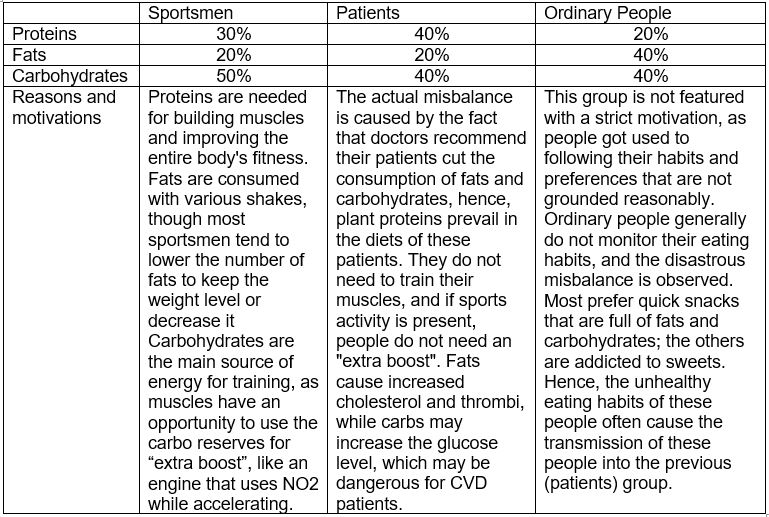Introduction
Because people have the alternative of three types of nutrients (proteins, fats, and carbohydrates), the functions of these elements may help define the aim of a diet, and further consideration which diet is more useful and healthy. Carbohydrates are generally regarded as the sources of quick energy, however, if they are not used, the organism transforms them into fats, which is the common reason for increased cholesterol, obedience, cardiovascular diseases, etc. (Nestle, 234)
Fats may be polyunsaturated and monounsaturated. The former is regarded to be less useful, and causing quicker obedience rates, while the latter is used by an organism for maintaining nerve systems and tissues flexible and elastic. The research aims to find out which diet: low-fat or low-carb will be more healthy, and whether there are risks of developing CVD if the diet is wrong. (McCullough and Feskovich, 1261)
Materials and Methods
The method of the study involves the study of the nutrition basic principles for defining the key usefulness and harm of the nutrition elements. The next step of the research is based on surveying people and health specialists on the matters of eating habits and patterns associated with the consumption and usefulness of fats and carbs in the everyday diet of people. The survey included people with CVD, sportsmen, and people in a street.
The materials of the study are the research papers engaged in assessing the diets, as well as the survey results in which people agreed to answer about their eating habits and health condition. The survey confirmed all the considerations by health specialists, as health researches are based on the considerations of usefulness and harm of carbohydrates as well as fats.
Results
The results of the survey revealed various tendencies in the eating habits of the people, and in general, the respondents were divided into three groups: sportsmen, cardiovascular patients, and ordinary people who were surveyed in the streets, trade centers, and cafes. They were asked about their rations and the reasons for ay habits, whether they think over the importance of correct nutrition.

Discussion
Consumption of carbohydrates is in the first place among all the three groups, though the aims of this proportion are different. While ordinary people mainly consume quick carbohydrates, patients base their ration on slow carbohydrates, and sportsmen prefer a balanced amount of both types of carbohydrates. The importance of both types varies depending on the aims and health background of the people, however, the consumption of quick carbohydrates should be minimized, as they cause caries, increase the glucose level in the blood, and, if not used, they are transformed into fats. (Kesten, 118)
As for the fats, it is evident that people are not able to live without consuming fats, however, the consumption should be balanced. Up to 2/3 of daily ration fats should be animal fats, and 1/3 – vegetable fat for ordinary people and sportsmen, and 1:1 within people with increased cholesterol. Moreover, diets and rations do not consider the amounts of poly- and monounsaturated fats. The latter is more useful for the nerve system as well as for improving metabolic processes in the organism. (Kesten, 349)
Conclusion
The question of which diet is more useful is unreasoned, as the healthiest way of nutrition is the properly balanced diet which includes the restricted amount of quick carbohydrates as well as polyunsaturated fats. Moreover, the restrictions should be reasonably grounded.
Works Cited
Hoffer, Abram. A Guide to Eating Well for Pure Health – Hoffer’s Laws of Natural Nutrition, Ontario, Canada: Quarry Press, Inc. 2001
Kesten, David. The Enlightened Diet. Spirituality and Health. Conari Press. 2003
Kesten, David. Feeding the Body, Nourishing the Soul. Conari Press. 2004
McCullough, Micheal. L., Feskovich, Gina. Diet quality and major chronic disease risk in men and women: moving towards improved dietary guidelines. American Journal of Clinical Nutrition. 2002 76: 1261-71.
Nestle, Morgan. Food Politics: How the Food Industry Influences Nutritional Health. University of California Press. 2003